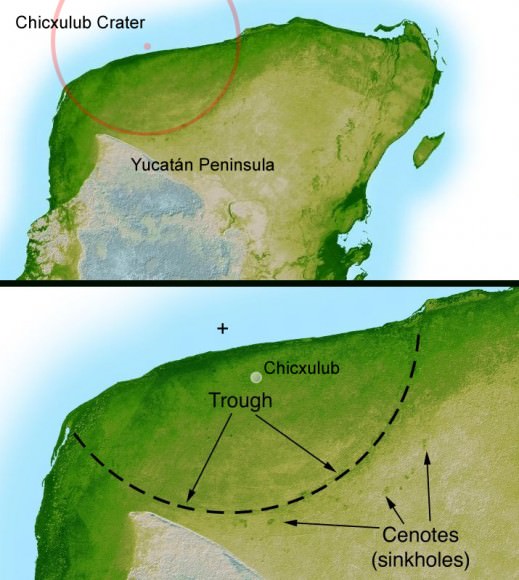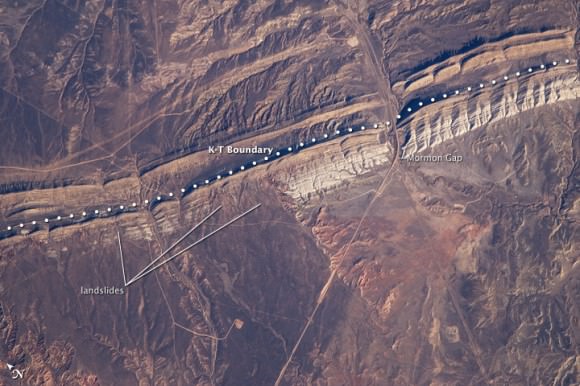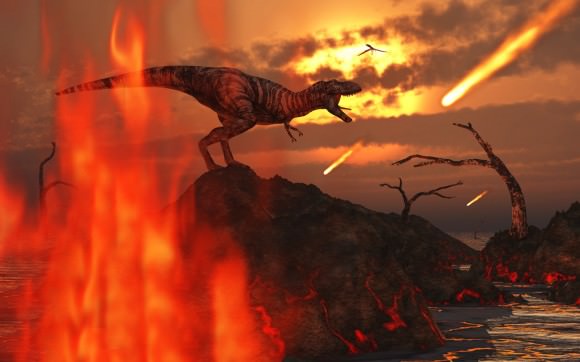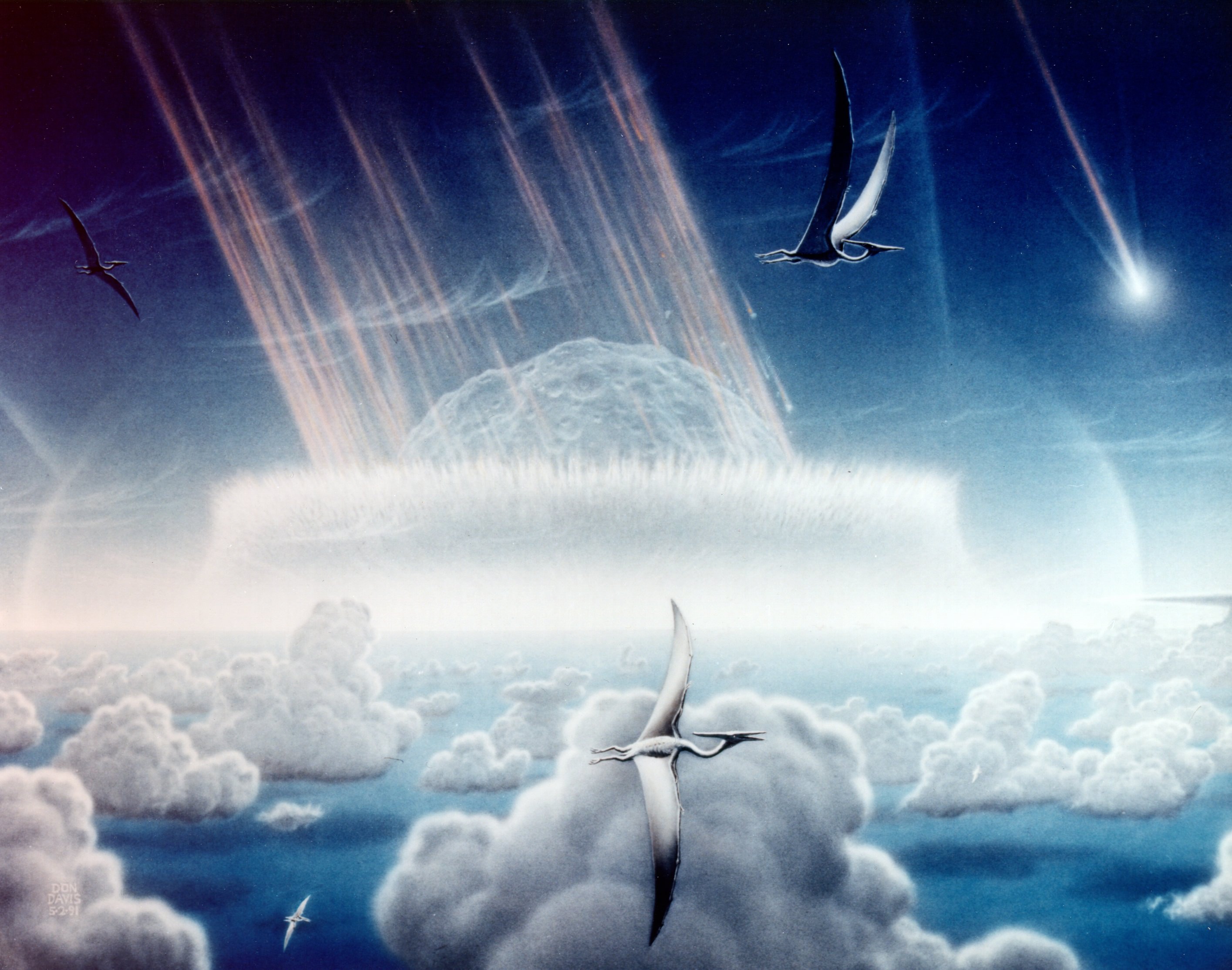What suddenly made the dinosaurs disappear 65 million or 66 million years ago? Whatever it was, all indications show that it was a massive extinction event. The fossil record not only shows dinosaurs disappearing, but also numerous other species of the era. Whatever it was, there was a sudden change in the environment that changed evolution forever.
The leading theory for this change is a small body (likely an asteroid or a comet) that slammed into Mexico’s Yucatan Peninsula. The impact’s force generated enough debris to block the Sun worldwide, killing any survivors of starvation.
The crater
There have been numerous theories proposed for the dinosaurs’ death, but in 1980 more evidence arose for a huge impact on the Earth. This happened when a father-son University of California, Berkeley research team — Luis Alvarez and Walter Alvarez — discovered a link with a 110-mile (177-kilometer) wide impact crater near the Yucatan coast of Mexico. It’s now known as Chicxulub.

It sounds surprising that such a huge crater wasn’t found until that late, especially given satellites had been doing Earth observation for the better part of 20 years at that point. But as NASA explains, “Chicxulub … eluded detection for decades because it was hidden (and at the same time preserved) beneath a kilometer of younger rocks and sediments.”
The data came from a Mexican company that was seeking oil in the region. The geologists saw the structure and guessed, from its circular shape, that it was an impact crater. Further observations were done using magnetic and gravity data, NASA said, as well as space observations (including at least one shuttle mission).
The layer
The asteroid’s impact on Earth was quite catastrophic. Estimated at six miles (9.7 kilometers) wide, it carved out a substantial amount of debris that spread quickly around the Earth, aided by winds in the atmosphere.

If you look in the fossil record all over the world, you will see a layer that is known as the “K-T Boundary”, referring to the boundary between the Cretaceous and Tertiary periods in geologic history. This layer, says the University of California, Berkeley, is made up of “glassy spheres or tektites, shocked quartz and a layer of iridium-enriched dust.”
Of note, iridium is a rare element on the surface of the Earth, but it’s fairly common in meteorites. (Some argue that the iridium could have come from volcanic eruptions churning it up from inside the Earth; for more information, see this Universe Today story.)
Was it simply ‘the last straw’?
While an asteroid (or comet) striking the Earth could certainly cause all the catastrophic events listed above, some scientists believe the dinosaurs were already on their last legs (so to speak) before the impact took place. Berkeley points to “dramatic climate variation” in the million years preceding the event, such as very cold periods in the tropical environment that the dinosaurs were used to.

What might have caused this were several volcanic eruptions in India around the same time. Some scientists believe it was the volcanic eruptions themselves that caused the extinction and that the impact was not principally to blame, since the eruptions could also have produced the iridium layer. But Berkeley’s Paul Renne said the eruptions were more a catalyst for weakening the dinosaurs.
“These precursory phenomena made the global ecosystem much more sensitive to even relatively small triggers, so that what otherwise might have been a fairly minor effect shifted the ecosystem into a new state,” Renne stated in 2013. “The impact was the coup de grace.”
Here on Universe Today there are several articles on the asteroids and the Chicxulub Crater. Astronomy Cast has an episode on asteroids as bad neighbors.


The Deccan Traps volcanism as well as the Chicxulub impact were caused by the same thing. The Earth’s core(s) rapid movement toward Earth-centricity, as described by the Gravity Theory of Mass Extinction, is able to explain why both events occurred. This movement caused an extreme wobble of the Earth, which has been identified, disturbing the orbit of the asteroid bringing it on its collision course.
No one questions why the most massive flood basalt volcanism occurred when supercontinents existed and have greatly diminished in intensity and size since Pangea’s breakup. Nor have they questioned why the rapid massive changes in sea level as well as carbon isotope excursion in addition to the massive flood basalt eruptions always occurred near the time of these mass extinctions. This coincidence is explained by the above theory.
There is one problem with this. Earth’s total mass did not change dramatically. Sure, densities changed from different locations. But that doesn’t impact total gravity. Gravity doesn’t reduce from density changes if the mass stays the same.
You didn’t read the theory, which does not require any change in mass of the Earth. Google Youtube Gravity Theory of Mass Extinction to get a brief summary of the theory.
There is no way that a shift in Earth’s center of gravity could affect the orbit of a distant asteroid. Nor is there any way the Earth’s core could ever have been significantly displaced from the Earth’s physical center. This “theory” is pure crackpottery.
During the late Cretaceous Period the Earth experienced a major wobble. I can provide a link to this report if needed. A major wobble would disturb the surrounding gravitational field (i.e., the space-time fabric). Any asteroids that were orbiting the sun and near the Earth would have had their trajectory altered.
The cause of the major wobble, I believe, was the movement of the Earth’s cores toward Earth-centricity as the continents rapidly moved longitudinally as Pangea broke apart.
Did you view the Youtube video I referenced above?
Staten-John — You would almost need to be within the Earth’s atmosphere for any “wobble” effect to cause an asteroid to alter it’s trajectory. The Earth is not a black hole. It is rather an insignificant object in our solar system.
Chicxulub may have been the second of a “one-two” impact punch. The Boltysh crater (24 km) in Ukraine is roughly the same age, possibly a little older. If these two events combined with an unusual episode of vulcanism, it could account for prolonged ecological stress on the Earth.
“Movement of the Earth’s cores..!” Cores (plural)… where do they come from? For me it’s sometimes hard to belive what people take as “fact”. These collection of youtube videos are ok if one has to kill some time (waiting for a flight), but if there is the tiniest chance of seriousness… then it would be on every tv channel already! “Cores”…. 😉
TedH,
Did you view the Youtube video? If you did, did you find anything that you would disagree with based on science?
As far as being on every tv channel I would only point to Alfred Wegener and his Continental Drift Theory which he proposed in 1914 but was not accepted until about the 1960s.
BlackWolfStanding,
I will post a link to a study that describes the late major Cretaceous wobble of the Earth and how it affected nearby planets. If it could do that, it could certainly affect an asteroid with much smaller mass.
BlackWolfStanding,
View this link. Of course, my explanation for the wobble is different than that proposed in the article. If the author had been aware of the theory I referenced, they might have attributed the wobble to it.
http://www.nature.com/news/2001/010628/full/news010628-15.html
The ‘Wobble’ you are speaking of is NOT the Wobble of Earth on it’s axis or for that matter the Earth/Moon system. It is the entire Solar System that is ‘wobbling.’
Please google — Solar System Wobble. This will make you freak out from what you were saying. Again. NO wobble from the Earth could effect other planets. You currently are totally misreading your links.
Did you know the Earth/Moon center of gravity is below the Earth’s surface? That the Earth wobbles because of this? Not effecting any other planet in the solar system.
BlackWolfStanding,
It is clear from the link I provided that the Earth wobble was not a solar system wobble:
“In each of the models, they found that the fluctuations of the Solar System’s dynamics remained constant going back to 65 million years ago. To their surprise, the frequency of the orbits of the inner planets then suddenly changed.”
Why do you think this sudden wobble occurred at this point in time? The writer attributes this wobble to “solar system dynamics” which, to me, means they cannot provide a cause. If it was a solar system wobble, can you provide any evidence of a change to the solar system barycenter and its cause 65mya?
The writer suggests that the orbit of Mercury had to be disturbed to cause a trajectory change to the asteroids.
If it were a solar system wobble, as you suggest, one would expect a disturbance to all of the planets not just the inner planets. Yet, the study suggests the only disturbance was to the Earth, Mars and Mercury, implying a localized disturbance:
“If the orbits of Mercury, Earth and Mars were being shaken up at this time, maybe asteroids were being shaken up too,” says Runnegard. This might possibly send a previously benign asteroid hurtling towards Earth.
I’m not sure why you mention the Earth/moon dynamic. BTW, it is the barycenter of the Earth/moon system that is below the Earth’s surface around which both the Earth and moon rotate, not the center of mass.
To summarize, the theory provided attributes the Earth’s wobble to the core elements moving back toward Earth-centricity, which rapidly increased surface gravity on the continental remnants of Pangea. This was the primary cause of the extinctions as well as the reason why the asteroid impact occurred at that time. It also explains why the massive flood basalt volcanism at the Deccan Traps was erupting.
A lot of people have been trying to tell you that you are wrong. And you are. There is simple physics that prevent any Earth ‘wobble’ from effecting anything in the solar system. Since the Earth had it’s moon long before the breakup of Pangea and that the moon still revolves around the Earth, that should tell you that no Earth based wobble is capable of effecting anything.
But please, keep on commenting and showing people how misinformed others can be.
BlackRockStanding,
My posts are not made to make people feel that they are misinformed.
I believe the theory explains many things and I welcome any valid criticism of the theory
“Subtle shifts in the solar system could have caused the dinosaur-devastating crash.”
“A bizarre wobble 65 million years ago,…may have caused the demise of the dinosaurs, new models of the Solar System suggest. ”
“The ultimate cause of the K-T impact – and the demise of the dinosaurs – may have been a chaos-induced change in Solar System dynamics,”
And finally, after corresponding with Bruce Runnegar, he stated that it was the Solar System that had the peculiar wobble that caused all of the planets of the inner solar system stability issues.
Now please…
BlackWolfStanding,
The question is……..what caused the subtle shifts in the Solar System? Mr. Runnegar doesn’t provide a specific cause for this, stating that there may have been a chaos-induced change in Solar System dynamics, leaving the reader to speculate about the precise causation of the wobble. The theory I support does provide a specific possible cause, which I have described.
And we are back to the beginning, physics preclude any wobble in the Earth from effecting anything in the solar system.
The Earth (with it’s Moon) will always rotate on it’s center of gravity. No matter where that center of gravity is located, the Earth will rotate on it. If the Earth at one point was weighted heavily to one side, it would have went into a tidal lock with the moon. There would not have been any force that could have prevented this. Since we are not in a tidal lock with the moon and there is no evidence that remotely suggested the Earth even slowed in rotation during that period, I can safely say that the Earth never ‘wobbled.’
BlackWolfStanding,
You are contradicting Mr.Runnegar’s statements. He stated:
1. There was a wobble of the Earth about 65mya.
2. The wobble of the Earth “might possibly send a previously benign asteroid hurtling towards Earth.”
3. “Being one of the inner planets, Mercury’s orbit would have been affected.”
The above statements (2. and 3.) clearly indicate that the Earth’s wobble did affect part of the solar system, contrary to your claim that physics would not permit this, i.e., you stated “I can safely say that the Earth never wobbled.” Since you just contradicted Mr. Runnegar regarding the existence of the wobble, you should contact him.
Finally, your assertion that if the Earth were “weighted” on one side it would go into tidal lock with the moon is speculation because, on a daily basis, the moon would see both sides of the planet, i.e., the high “weight” side and the low “weight” side, effectively cancelling out the change in gravitational force on the moon.